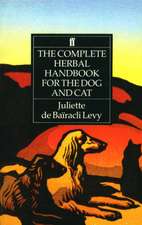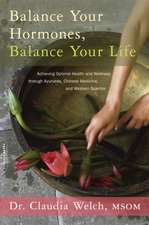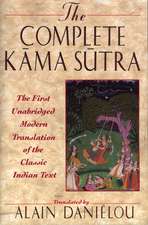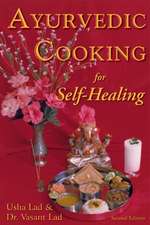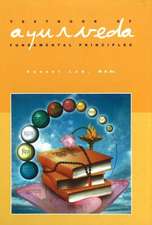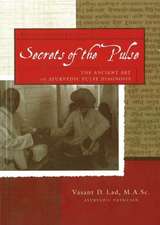The Complete Book Of Ayurvedic Home Remedies
Autor Vasant Laden Limba Engleză Paperback – 2 noi 2006
| Toate formatele și edițiile | Preț | Express |
|---|---|---|
| Paperback (2) | 97.18 lei 3-5 săpt. | +54.69 lei 4-10 zile |
| Little Brown Book Group – 2 noi 2006 | 97.18 lei 3-5 săpt. | +54.69 lei 4-10 zile |
| HARMONY – 31 mar 1999 | 112.80 lei 3-5 săpt. |
Preț: 97.18 lei
Preț vechi: 123.71 lei
-21% Nou
Puncte Express: 146
Preț estimativ în valută:
18.60€ • 19.21$ • 15.48£
18.60€ • 19.21$ • 15.48£
Carte disponibilă
Livrare economică 04-18 martie
Livrare express 15-21 februarie pentru 64.68 lei
Preluare comenzi: 021 569.72.76
Specificații
ISBN-13: 9780749927653
ISBN-10: 0749927658
Pagini: 336
Ilustrații: black and white line drawings
Dimensiuni: 233 x 186 x 27 mm
Greutate: 0.68 kg
Editura: Little Brown Book Group
Locul publicării:United Kingdom
ISBN-10: 0749927658
Pagini: 336
Ilustrații: black and white line drawings
Dimensiuni: 233 x 186 x 27 mm
Greutate: 0.68 kg
Editura: Little Brown Book Group
Locul publicării:United Kingdom
Notă biografică
Vasant Lad holds a Bachelor of Ayurvedic Medicine and Surgery degree and a Master of Ayurvedic Science degree. He is a world-renowned expert on the practices and health benefits of Ayurvedic medicine and has lectured at seminars and workshops.
Extras
Introduction
The Need for Healing
Ayurveda is the art of daily living in harmony with the laws of nature. It is an ancient, natural wisdom of health and healing, a science of life. The aims and objectives of this science are to maintain the health of a healthy person and to heal the disease of an unhealthy person. Both prevention (maintenance of good health) and healing are carried out by entirely natural means.
According to Ayurveda, health is a perfect state of balance among the bodys three fundamental energies or doshas (vata, pitta, kapha) and an equally vital balance among body, mind, and the soul or consciousness.
Ayurveda is a profound science of living that encompasses the whole of life and relates the life of the individual to the life of the universe. It is a holistic system of healing in the truest sense. Body, mind, and consciousness are in constant interaction and relationship with other people and the environment. In working to create health, Ayurveda takes into consideration these different levels of life and their interconnectedness.
As a science of self-healing, Ayurveda encompasses diet and nutrition, lifestyle, exercise, rest, and relaxation, meditation, breathing exercises, and medicinal herbs, along with cleansing and rejuvenation programs for healing body, mind, and spirit . Numerous adjunct therapies such as sound, color, and aroma therapy may also be employed . The purpose of this book is to acquaint you with these natural methods, so you can make the lifestyle choices and learn the self-learning modalities that are right for you in order to create, maintain, or restore health and balance.
Ayurveda is a Sanskrit word that means the science of life and longevity. According to this science, every individual is both as creation of cosmic energies and a unique phenomenon, a unique personality. Ayurveda teaches that we all have a constitution, which is our individual psychobiological makeup. From the moment of conception, this individual constitution is created by the universal energies of ether, air, fire, water, and earth.
These five elements combine into the three fundamental energies, or doshas. Ether and air constitute vata, which is the energy of movement; fire and water constitute pitta, the principle of digestion or metabolism, the transformation of matter into energy; and water and earth make up kapha, the energy structure and lubrication. When the make sperm and the female egg join at the time of fertilization, the vatta-pitta-kapha factors from the parents bodies that are most active and predominant at the moment, due to the season, the time, the emotional state, and the quality of their relationship, form a new individual with a particular constellation of qualities.
In modern terms we speak of this blueprint of the individual as our inherited genetic code; from ancient times Ayurveda has called it our prakruti or individual constitution, a constant factor which does not change throughout life. It is our own unique pattern of energy, our combination of physical, mental, and emotional characteristics and predispositions.
Though the underlying structure of our prakruti remains a fixed reality, our home base or essential individuality, it is constantly bombarded by numerous forces. Changes in age and in our external environment, alternating heat and cold as the seasons pass, our endlessly shifting thoughts, feelings, and emotions, the quality and quantity of the food we eat, continuously affect us. Unhealthy diet, excess stress, insufficient rest or exercise, and repressed emotions, all disturb our doshic balance. Depending on the type of changes and the individuals underlying constitution, various ailments may develop:
Some individuals experience an increase or aggravation of kapha, leading to conditions such as colds, congestion, sneezing, and allergic manifestations as well as attachment, greed, and possessiveness.
A pitta individual may become highly critical, angry, or perfectionistic, or may develop physical symptoms such as acid indigestion, heartburn, diarrhea, dysentery, hives, rash, or acne.
Vata imbalances may manifest as constipation, abdominal distention, sciatica, arthritis, or insomnia, along with psychological symptoms such as fear, anxiety, and insecurity.
All these illnesses and conditions, in addition to the countless others that lead to human suffering, are due to alterations in the bodys inner ecology. These upset the individuals balance, creating subtle biochemical changes which ultimately lead to disease. This is why the Ayurvedic system of medicine speaks of the need for healing for every individual in every walk of life.
As the internal and external conditions of our lives change, if we are going to remain healthy we need to constantly adjust in order to maintain equilibrium. Some of this adjusting takes place automatically due to the beautiful wisdom and intelligence with which our bodies have been designed. but much demands conscious choice.
To maintain health and balance, we have to juggle with the three doshas, taking action to increase or decrease vata, pitta, or kapha as conditions demand. This requires moment to moment awareness, moment to moment consciousness, moment to moment healing.
Thus healinghealthy, balanced, conscious living in the fullness of the present momentis really a way of life. Ayurveda is not a passive form of therapy but rather asks each individual to take responsibility for his or her own daily living. Through our diet, our relationships, our job, our numerous responsibilities, and our daily life as a whole, we can take simple actions for prevention, self-healing, wholeness, and growth toward fulfillment.
According to Ayurveda, our life has a purpose. Simply stated, that purpose is to know or realize the Creator (Cosmic Consciousness) and to understand our relationship with That, which will entirely influence our daily living. This great purpose is to be achieved by balancing four fundamental aspects of life: dharma, which is duty or right action; artha, material success or wealth; kama, positive desire; and moshka, spiritual lberation. These are called the four purusharthas, the four great aims or achievements in the life of any individual.
The foundation of all these facets of life is health. To maintain dharma and carry out our duties and responsibilities to ourselves and others, we must be healthy. Likewise, in order to create affluence and achieve success in action, good health is indispensable. To have creative, positive desire, we need a healthy mind and consciousness, a health body, and healthy perception. (Desirekamais sometimes translated as sex and refers to progeny and family life, but it is really the positive energy or force of desire that generates and propels any creative work.) And moshka or spiritual liberation is nothing but perfect harmony of body, mind, and consciousness or soul. Thus the whole possibility of achievement and fulfillment in life rests on good health.
In the quarter century that I have been practicing medicine, I have worked in surgery, gynecology, obstetrics, and pediatrics, as well as in general medicine, treating thousands of individuals in all stages and walks of life. I have repeatedly observed that lifestyle choices, such as diet, exercise, and daily routine, can be a potent source of healing as well as a cause of disease. Many health problems seem intertwined with the stresses of daily life, family and relationship problems, and worries about job and money. Others are directly connected to eating the wrong kinds of food or getting too much or too little exercise.
I have also grown more and more aware that illness provides us with an invitation for self-transformation, an opportunity to change our way of thinking, feeling, eating, and in general caring form ourselves and our lives. It never ceases to amaze and delight me how quickly and powerfully life can be set on the right track and balance restored simply through a proper diet, herbal medicines, meditation, an appropriate exercise program. and other purely natural means.
The remedies in this book come from my own practical clinical experience, based on principles and practices developed over centuries. The tradition of Ayurveda extends back over more than five thousand years of continuous daily practice, from ancient times to the present day. It is not a recently developed system of alternative healing but an enduring science of life that has never lost its integrity and essential nature. You can imagine how much wisdom it contains and how much practical knowledge it has accumulated over a span of five millennia
About three thousand years ago (around 900 B.C.), the long oral tradition of Ayurveda took new form when three great scholarsCharaka, Sushruta, and Vag Bhattawrote down the principles of this ancient wisdom. Their textbooks are still used by students, practitioners, and teachers in Ayurvedic medical schools and colleges throughout India.
In a profound sense, Ayurveda is the mother of all healing systems. From its eight principal branches (pediatrics and obstetrics, gynecology, opthalmology, geriatrics, otolaryngology, toxicology, general medicine, and surgery) have come the main branches of medicine as it is practiced today, as well as many modern healing modalities, including massage, diet and nutritional counseling, herbal remedies, plastic surgery, psychiatry, polarity therapy, kinesiology, shiatsu, acupressure and acupuncture, color and gem therapy, and meditation. All these have roots in Ayurvedic philosophy and practice.
The great sage-physician Charaka, one of the founders of Ayurvedic medicine, said A physician, though well versed in the knowledge and treatment of disease, who does not enter into the heart of the patient with the virtue of light and love, will not be able to heal the patient. To the best of my ability, I have followed this advice all my life, and I would urge you to follow it in using this knowledge to help mothers and to heal yourself.
Love is the essence of our life. I have written this book with love, and I offer it to you, dear reader, with the hope that the suggestions offered here will become a vital part of your self-healing and continued well-being.
The Need for Healing
Ayurveda is the art of daily living in harmony with the laws of nature. It is an ancient, natural wisdom of health and healing, a science of life. The aims and objectives of this science are to maintain the health of a healthy person and to heal the disease of an unhealthy person. Both prevention (maintenance of good health) and healing are carried out by entirely natural means.
According to Ayurveda, health is a perfect state of balance among the bodys three fundamental energies or doshas (vata, pitta, kapha) and an equally vital balance among body, mind, and the soul or consciousness.
Ayurveda is a profound science of living that encompasses the whole of life and relates the life of the individual to the life of the universe. It is a holistic system of healing in the truest sense. Body, mind, and consciousness are in constant interaction and relationship with other people and the environment. In working to create health, Ayurveda takes into consideration these different levels of life and their interconnectedness.
As a science of self-healing, Ayurveda encompasses diet and nutrition, lifestyle, exercise, rest, and relaxation, meditation, breathing exercises, and medicinal herbs, along with cleansing and rejuvenation programs for healing body, mind, and spirit . Numerous adjunct therapies such as sound, color, and aroma therapy may also be employed . The purpose of this book is to acquaint you with these natural methods, so you can make the lifestyle choices and learn the self-learning modalities that are right for you in order to create, maintain, or restore health and balance.
Ayurveda is a Sanskrit word that means the science of life and longevity. According to this science, every individual is both as creation of cosmic energies and a unique phenomenon, a unique personality. Ayurveda teaches that we all have a constitution, which is our individual psychobiological makeup. From the moment of conception, this individual constitution is created by the universal energies of ether, air, fire, water, and earth.
These five elements combine into the three fundamental energies, or doshas. Ether and air constitute vata, which is the energy of movement; fire and water constitute pitta, the principle of digestion or metabolism, the transformation of matter into energy; and water and earth make up kapha, the energy structure and lubrication. When the make sperm and the female egg join at the time of fertilization, the vatta-pitta-kapha factors from the parents bodies that are most active and predominant at the moment, due to the season, the time, the emotional state, and the quality of their relationship, form a new individual with a particular constellation of qualities.
In modern terms we speak of this blueprint of the individual as our inherited genetic code; from ancient times Ayurveda has called it our prakruti or individual constitution, a constant factor which does not change throughout life. It is our own unique pattern of energy, our combination of physical, mental, and emotional characteristics and predispositions.
Though the underlying structure of our prakruti remains a fixed reality, our home base or essential individuality, it is constantly bombarded by numerous forces. Changes in age and in our external environment, alternating heat and cold as the seasons pass, our endlessly shifting thoughts, feelings, and emotions, the quality and quantity of the food we eat, continuously affect us. Unhealthy diet, excess stress, insufficient rest or exercise, and repressed emotions, all disturb our doshic balance. Depending on the type of changes and the individuals underlying constitution, various ailments may develop:
Some individuals experience an increase or aggravation of kapha, leading to conditions such as colds, congestion, sneezing, and allergic manifestations as well as attachment, greed, and possessiveness.
A pitta individual may become highly critical, angry, or perfectionistic, or may develop physical symptoms such as acid indigestion, heartburn, diarrhea, dysentery, hives, rash, or acne.
Vata imbalances may manifest as constipation, abdominal distention, sciatica, arthritis, or insomnia, along with psychological symptoms such as fear, anxiety, and insecurity.
All these illnesses and conditions, in addition to the countless others that lead to human suffering, are due to alterations in the bodys inner ecology. These upset the individuals balance, creating subtle biochemical changes which ultimately lead to disease. This is why the Ayurvedic system of medicine speaks of the need for healing for every individual in every walk of life.
As the internal and external conditions of our lives change, if we are going to remain healthy we need to constantly adjust in order to maintain equilibrium. Some of this adjusting takes place automatically due to the beautiful wisdom and intelligence with which our bodies have been designed. but much demands conscious choice.
To maintain health and balance, we have to juggle with the three doshas, taking action to increase or decrease vata, pitta, or kapha as conditions demand. This requires moment to moment awareness, moment to moment consciousness, moment to moment healing.
Thus healinghealthy, balanced, conscious living in the fullness of the present momentis really a way of life. Ayurveda is not a passive form of therapy but rather asks each individual to take responsibility for his or her own daily living. Through our diet, our relationships, our job, our numerous responsibilities, and our daily life as a whole, we can take simple actions for prevention, self-healing, wholeness, and growth toward fulfillment.
According to Ayurveda, our life has a purpose. Simply stated, that purpose is to know or realize the Creator (Cosmic Consciousness) and to understand our relationship with That, which will entirely influence our daily living. This great purpose is to be achieved by balancing four fundamental aspects of life: dharma, which is duty or right action; artha, material success or wealth; kama, positive desire; and moshka, spiritual lberation. These are called the four purusharthas, the four great aims or achievements in the life of any individual.
The foundation of all these facets of life is health. To maintain dharma and carry out our duties and responsibilities to ourselves and others, we must be healthy. Likewise, in order to create affluence and achieve success in action, good health is indispensable. To have creative, positive desire, we need a healthy mind and consciousness, a health body, and healthy perception. (Desirekamais sometimes translated as sex and refers to progeny and family life, but it is really the positive energy or force of desire that generates and propels any creative work.) And moshka or spiritual liberation is nothing but perfect harmony of body, mind, and consciousness or soul. Thus the whole possibility of achievement and fulfillment in life rests on good health.
In the quarter century that I have been practicing medicine, I have worked in surgery, gynecology, obstetrics, and pediatrics, as well as in general medicine, treating thousands of individuals in all stages and walks of life. I have repeatedly observed that lifestyle choices, such as diet, exercise, and daily routine, can be a potent source of healing as well as a cause of disease. Many health problems seem intertwined with the stresses of daily life, family and relationship problems, and worries about job and money. Others are directly connected to eating the wrong kinds of food or getting too much or too little exercise.
I have also grown more and more aware that illness provides us with an invitation for self-transformation, an opportunity to change our way of thinking, feeling, eating, and in general caring form ourselves and our lives. It never ceases to amaze and delight me how quickly and powerfully life can be set on the right track and balance restored simply through a proper diet, herbal medicines, meditation, an appropriate exercise program. and other purely natural means.
The remedies in this book come from my own practical clinical experience, based on principles and practices developed over centuries. The tradition of Ayurveda extends back over more than five thousand years of continuous daily practice, from ancient times to the present day. It is not a recently developed system of alternative healing but an enduring science of life that has never lost its integrity and essential nature. You can imagine how much wisdom it contains and how much practical knowledge it has accumulated over a span of five millennia
About three thousand years ago (around 900 B.C.), the long oral tradition of Ayurveda took new form when three great scholarsCharaka, Sushruta, and Vag Bhattawrote down the principles of this ancient wisdom. Their textbooks are still used by students, practitioners, and teachers in Ayurvedic medical schools and colleges throughout India.
In a profound sense, Ayurveda is the mother of all healing systems. From its eight principal branches (pediatrics and obstetrics, gynecology, opthalmology, geriatrics, otolaryngology, toxicology, general medicine, and surgery) have come the main branches of medicine as it is practiced today, as well as many modern healing modalities, including massage, diet and nutritional counseling, herbal remedies, plastic surgery, psychiatry, polarity therapy, kinesiology, shiatsu, acupressure and acupuncture, color and gem therapy, and meditation. All these have roots in Ayurvedic philosophy and practice.
The great sage-physician Charaka, one of the founders of Ayurvedic medicine, said A physician, though well versed in the knowledge and treatment of disease, who does not enter into the heart of the patient with the virtue of light and love, will not be able to heal the patient. To the best of my ability, I have followed this advice all my life, and I would urge you to follow it in using this knowledge to help mothers and to heal yourself.
Love is the essence of our life. I have written this book with love, and I offer it to you, dear reader, with the hope that the suggestions offered here will become a vital part of your self-healing and continued well-being.



